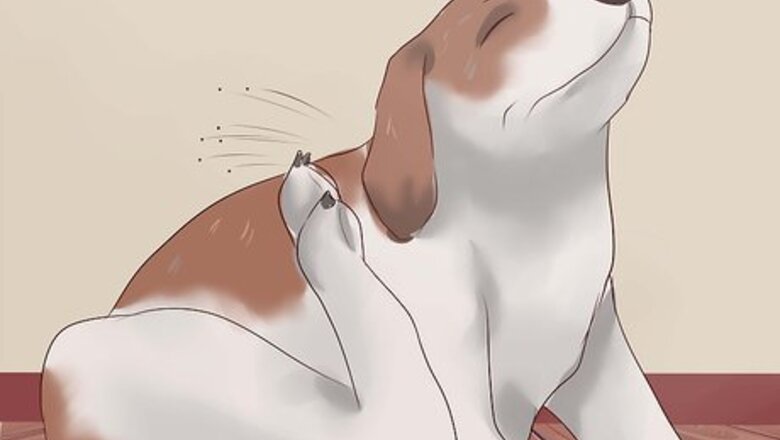
views
X
Expert Source
Belgin AltundagCertified Dog Trainer
Expert Interview. 11 August 2021
Using Topical Insecticides

Make your dog an unappealing host for ticks. It is safest to keep your dog away from wooded areas and tick habitats, but if you do decide to take him for a hike, you can make him less appetizing to these bloodthirsty bugs. Try applying a topical insecticide directly to your dog's skin for long-term protection. This may be the easiest solution. A one-time dose will protect your dog from fleas for anywhere from 30 to 90 days. Try fitting your dog with a tick collar. Tick collars need to be changed every 3 to 4 months, but they are relatively non-intrusive and they will kill ticks. Many tick collars contain a dog-safe pesticide--an acaricide--that kills ticks without poisoning your dog. Some acaricides kill ticks on contact; others are absorbed into your dog's bloodstream, over time, and kill ticks that attach and feed. Try using tick sprays. Tick-repellent sprays are typically designed for a one-time use, and they tend to wear off more quickly than the other options. Tick sprays are often made from natural ingredients, whereas many other tick repellents are based on pesticides and insecticides. Be careful not to mix medications. Ask your veterinarian before starting your dog on a new anti-tick product, particularly if it's a pesticide.
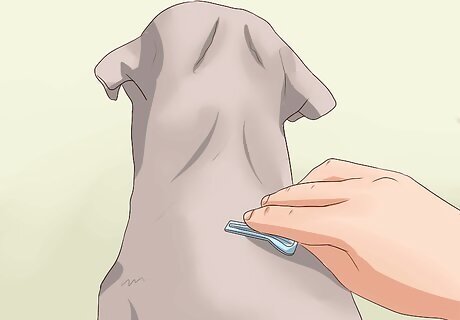
Use topical insecticides. Apply these treatments to a small area on the back of the dog, between its shoulders; they may be the easiest product to use, and they typically last the longest. These medications must be reapplied once a month, typically, although some products may last as long as 90 days. Avoid touching your dog's back for a few hours after you've applied the product to give it time to sink into the skin. Some products kill fleas and ticks, and others just fleas, so check the label carefully. Active ingredients may include permethrin, pyrethrin, or fipronil. Do not use a product containing permethrin on cats: it can be deadly. Visit a pet supply store or a veterinarian and explore the range of products available to you.
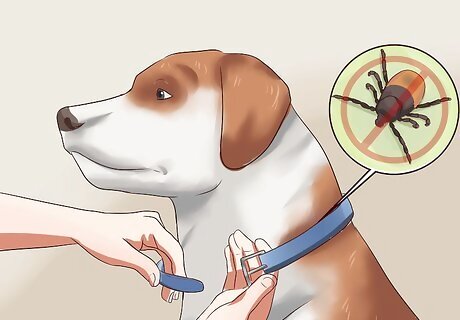
Use a tick collar. These can be used instead of--or in conjunction with--topical flea medications, and they fit alongside most regular dog collars. Check the package to see how long the collar will protect your dog. Many collars must be changed every 3 to 4 months for optimal protection. Be aware that many collars lose their effectiveness when they get wet. If your dog spends a lot of time in the water, then this may not be the solution for you. To get the right degree of snugness, you should just be able to get two fingers between the collar and the neck of your dog. Be sure to cut off any excess collar to prevent your dog from chewing on it.
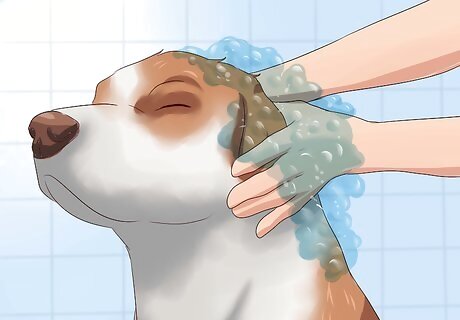
Bathe your dog in flea-and-tick shampoo. These products are primarily designed to rid your dog of the ticks that he already has on him, although some shampoos have a lingering anti-tick effect. You can find medicated shampoos in your local grocery or pet store. To properly use a flea and tick shampoo, you must be sure to work the shampoo in over your dog's entire body, and then leave it on for at least 10 minutes before you rinse it off. This is true of almost any medicated shampoo. Remember to protect your dog's eyes and ears. Consider placing a white towel beneath your dog while you bathe it. Ticks may fall off of your dog and onto the towel, making them easier to spot and kill.
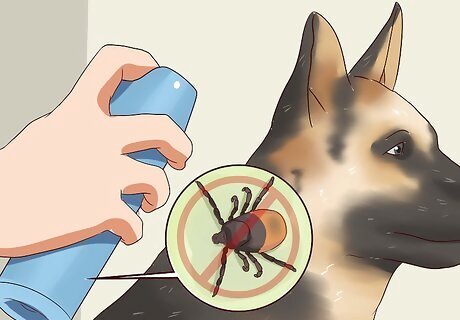
Use a tick spray. This may be a good solution if you don't normally have a problem with ticks, but you are taking your dog to an area that you know is heavily infested. Tick sprays are usually designed for temporary, immediate use, but you can apply them as needed. Follow your veterinarian's and the manufacturer's directions on how often to spray, and spray in a well-ventilated area. Sprays often contain permethrin or pyrethrin. Many tick sprays are made from natural ingredients. This is a good alternative if you worry about your dog being exposed to pesticides. Most other tick preventatives are based on insecticides or pesticides. Flea and tick control sprays can come as aerosols or pump bottles. When using a spray, you do not have to soak your dog with the spray, but be sure to spray every inch of its body. Spray a small amount on a cotton ball to apply the product around the eyes and ears. Do not get any of these products in the eyes.
Using Natural Tick Repellents

Consider keeping your dog pesticide-free. The use of pesticides to treat pets--particularly permethrin, which is toxic to cats and has been known to kill indiscriminately--is somewhat controversial. Read the ingredients listed on any commercial anti-tick product, and do your research to make sure that they're safe for your dog. Ask your veterinarian before using any pesticide on your dog.

Consider making your own anti-tick powder. If you want to avoid the toxins and pesticides found in most tick repellents, you can use ingredients from your home and garden to protect your dog from tick attacks. Mix equal quantities of diatomaceous earth (natural diatomaceous earth, made from tiny fossilized water plants--not pool-grade diatomaceous earth); Neem powder (Indian tree containing the pesticide oneliminoid, the powder which can be found in health stores); and yarrow (a skin-soothing herb and natural tick repellent that grows wild across the northern hemisphere). Pour the mixture into a shaker jar. Ruffle your dog's hair to expose the skin, and methodically apply small amounts of the powder from the back of your dog to the front of your dog. Be sure to cover the neck area. For a medium-sized dog, you should need about a teaspoon's worth of the dust. Apply it to your dog each month, and it may keep away ticks.
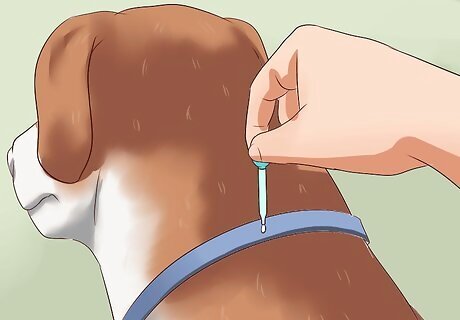
Make a homemade herbal tick "collar". Mix two tablespoons of almond oil with Rose Geranium Oil or Palo Santo, and dab a few drops on your dog's neck before you head out into the woods. You can also place the oil directly onto the dog's collar. Re-apply weekly. To make a citrus repellent: Cut a lemon into quarters and put it into a pint jar. Cover it with boiling water and let it steep overnight. Put the solution in a spray bottle and spray all over the dog, especially behind the ears, around the head, at the base of the tail and in the arm pits.

Make natural tick shampoo. Mix several drops of Palo Santo into your favorite organic lavender shampoo. Lather into your dog's fur, and let the suds sit on your dog for twenty minutes before rinsing. This may work to kill any existing ticks and prevent new ones from latching on.

Make a natural flea and tick remedy with apple cider vinegar. Apple cider vinegar may may your dog's blood slightly more acidic, making it less appealing to ticks and fleas. Add two tablespoons of apple cider vinegar to your dog's food or water dish as a preventative measure. Consider spraying your dog with apple cider vinegar instead of pesticidal tick repellent. Fill a spray bottle with the cider vinegar and lightly coat every inch of your dog before you venture into a tick-infested area. Bear in mind that this is a home remedy, and it may not be as immediately effective as pesticide treatments. However, apple cider vinegar is not as potentially threatening to your dog's health.
Avoiding Tick-Infested Areas

Keep your dog away from known tick habitats. Ticks inhabit dense, wooded vegetative areas--patches of overgrown shrubs, meadows with thick brush, and places where the ground is covered with decaying leaves. Ticks engage in a behavior called "questing": they climb low shrubs and grass until they're 18–24 inches (45.7–61.0 cm) off the ground, and they lurk in wait for animals--like your dog--to brush against their perch. Be especially wary if you're passing through an area with a profusion of low, thick underbrush. Ticks have heat sensors that can detect the body heat emitted by a dog. The tick uses its legs to grab onto your dog's fur as the dog passes by. It worms its way through the fur like a covert operative, like a heat-seeking, blood-thirsty missile toward the skin. The tick begins to gorge itself on the dog's blood in order to fertilize its eggs. Stay on the trails when hiking with your pet, and make sure that your pet remains with you. Avoid wooded areas and long grasses where ticks are common. If your dog runs off the trail (as they often do), make sure to check him for ticks when you get home.
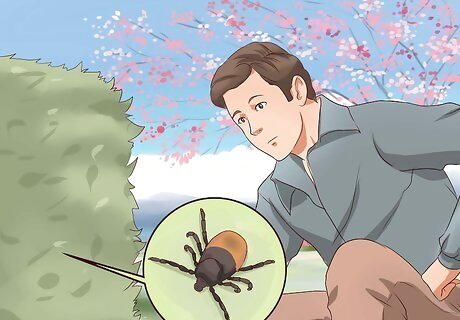
Identify tick habitat in your yard. If your dog spends a lot of time running about your yard, it may be at risk of encountering ticks. Ticks don't usually live out in the open--say, in the center of your lawn. Ticks congregate on the fringes: where yards border wooded areas; where there are ornamental plantings and thick gardens; and anywhere shady, where leaves are decaying with high humidity. Rake up decaying leaves, trim overgrown brush, and keep your dog from sticking its nose into wooded areas. Keep your lawn trimmed low (below ankle height) so that it doesn't become a hospitable environment for ticks. Secure your trash cans with strong lids; take out any rock piles and brushy cover. This helps keep away rodents that may carry ticks.
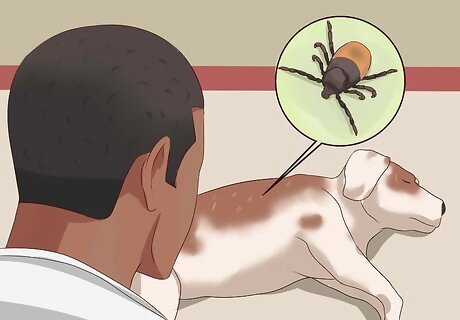
Check your dog for ticks every day, especially if it's been outside. Be thorough. Dogs tend to pick up many more ticks than humans do. Groom your dog after a walk in the woods. Work through its fur with a fine-toothed comb to remove any ticks that are clinging to the hairs. Part the fur with your hands and inspect your dog's skin to make sure that no ticks have already taken root. Feel for irregular lumps. Remember to check between your dog's toes, behind and in the ears, in the armpits and belly, and all around the tail and the head. If you find a tick on your dog, remove it right away. Use tweezers or a tick scoop, and be gentle. If you're using tweezers: Grasp the tick as close to the skin as possible by gripping its head. Steadily pull upward until the tick releases his grip. Do not twist or jerk the tick or you might break off the head or mouth parts; you do not want to leave the tick head embedded in your pet's skin. Do not squeeze to the point of crushing the tick, or you may may spread any diseases that the tick is carrying. Ask your veterinarian to conduct a tick check at each exam. This is a great way to ensure that you haven't missed anything. Carefully watch the vet conduct the tick check so that you can improve your own technique.
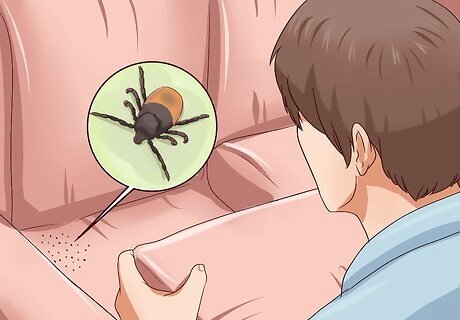
Check your home for ticks. Dogs can carry ticks in that do not latch on immediately, but instead spread throughout a home. Keep your eyes peeled for small, eight-legged, spider- or mite-like creatures. Be aware that ticks may take a while to work their way through the fur before they actually bite a dog. If your dog comes into the house before the tick has properly latched on, there's a chance that the tick will instead find its way onto you or one of your family members. Ticks love interior textures that are reminiscent of their outdoor environment: thick carpets or fabrics--anywhere that they can hide. If you think that you might have a tick infestation, consider thoroughly vacuuming your home. Be vigilant. Consider spreading diatomaceous earth, baking soda, or borax into your carpet to kill fleas and ticks. Diatomaceous earth is toxic to ticks, but not to humans or dogs; however, you should be sparing with baking soda and borax treatments.


















Comments
0 comment